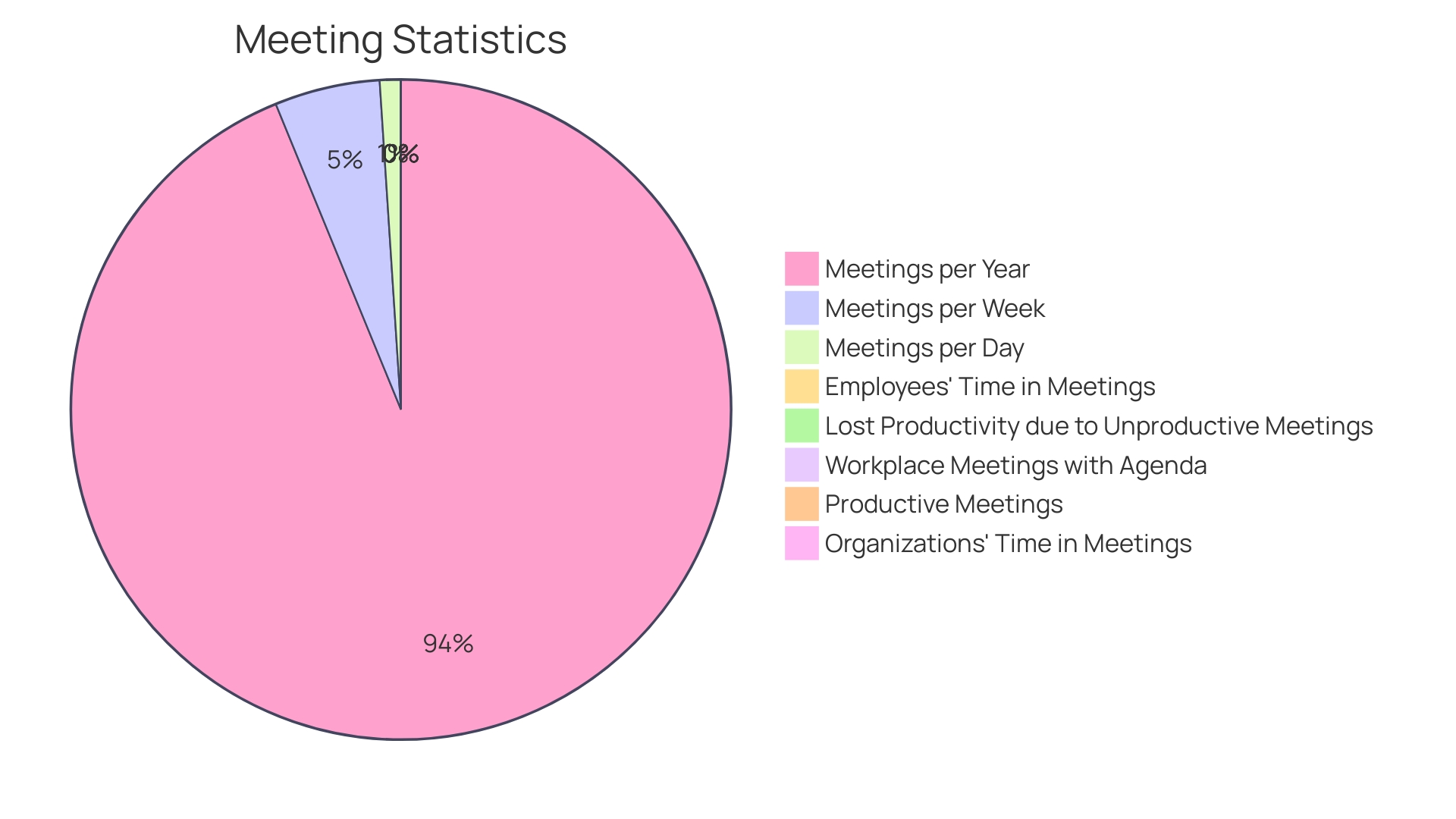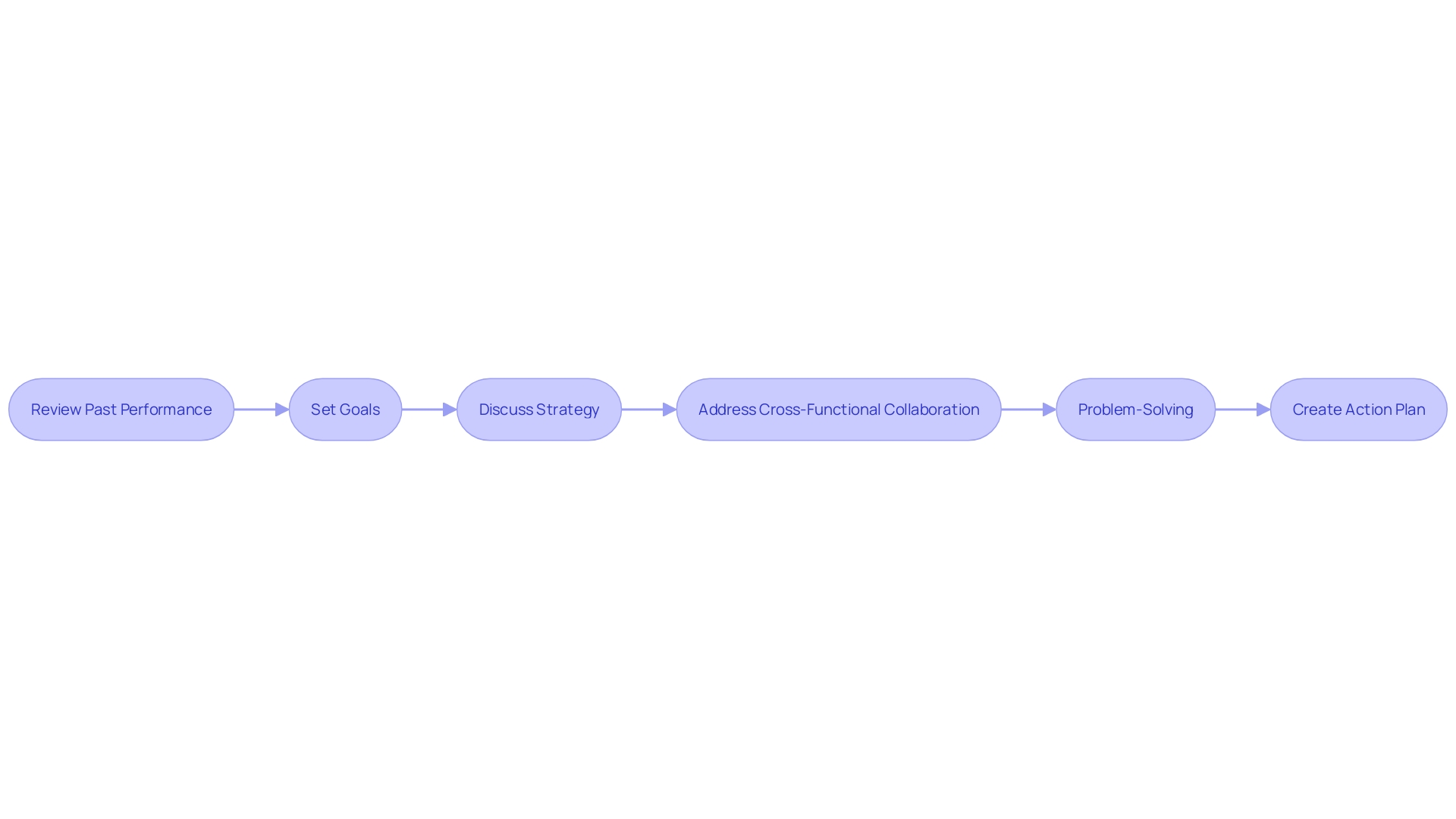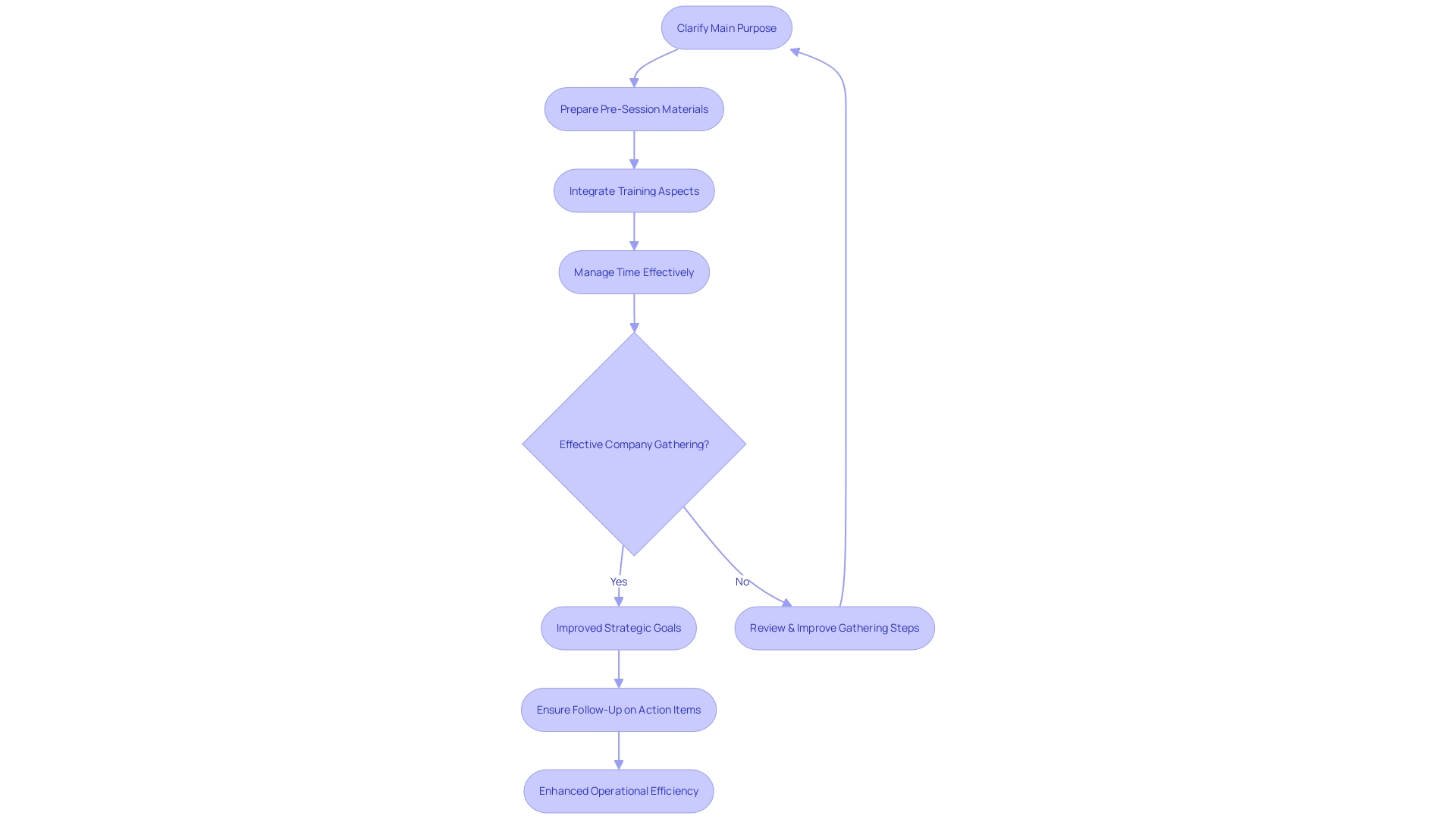The Power of Meeting Quarterly: Boosting Productivity and Collaboration

Introduction
Quarterly meetings are more than just routine check-ins; they are pivotal moments that harness the collective momentum of a team. These gatherings offer an opportunity to reflect on achievements, set strategic activities, and propel the company forward. With over 1 billion quarterly meetings held annually in the United States, it’s crucial to make each one count.
By transforming these sessions into crucibles of decision-making, emotion, and idea generation, organizations can create a culture of engagement and collaboration. In this article, we will explore the benefits of quarterly meetings, how to prepare for them, key components to include, tips for running successful meetings, and solutions to common implementation challenges. Let’s dive in and discover how these meetings can be a cornerstone of organizational progress.
Understanding Quarterly Meetings
At the core of many successful organizations resides the rhythmic pulse of quarterly gatherings. These gatherings are more than just calendar placeholders; they are pivotal moments that harness the collective momentum of the team. Every three months, like clockwork, stakeholders come together to reflect on small milestones that, when strung together, paint a picture of tangible progress. It’s a period where the rear view is just as important as the windshield, looking back on achievements and setting sights on strategic activities that propel the company forward. By harmonizing time and energy with clarity, these gatherings ensure that every decision is part of a deliberate march towards shared objectives.
The significance of these gatherings is emphasized by the astonishing quantity of them conducted throughout the United States—over 1 billion annually, with the typical employee devoting up to one-third of their week in meetings. Yet, with an estimated $37 billion lost annually to unproductive gatherings, the emphasis on ensuring each quarterly gathering is meaningful has never been more crucial. It’s about transforming these sessions from a routine exchange of information to a crucible of decision-making, emotion, and idea generation.
In this era of rapid change, where layoffs and stress have become all too common, the format of our gatherings can either contribute to a culture of engagement or exacerbate feelings of disconnection. Through requesting careful preparation and embracing extended writing, we can extract the core of what needs to be discussed, sometimes even resolving issues before the gathering commences.
Quarterly gatherings, therefore, are not just a tick on the corporate calendar but a structured approach to building a lasting culture. They provide a chance to commemorate advancement, readjust course, and guarantee that every viewpoint is acknowledged—because, as some of the most skilled session facilitators understand, the incorporation of varied perspectives is not only advantageous, it’s vital for the well-being of any entity.

Benefits of Quarterly Meetings for Productivity and Collaboration
The importance of quarterly gatherings goes beyond mere routine check-ins; they are essential for cultivating an ‘operating system’ within an organization. Think of it as the foundational structure that enables team members to effectively collaborate, drive change, and support one another. These gatherings establish a space where teams can synchronize their efforts, ensuring that everyone is paddling in unison towards shared goals. They’re not just for status updates but are a time for exchanging ideas, sparking innovation, and problem-solving collectively. They help in embedding a culture of continuous improvement, as seen in successful models like the Toyota Production System.
For example, a Latin American bank aiming to overhaul its digital strategy faced initial setbacks due to unclear roles and responsibilities. It wasn’t until they reevaluated their approach to teamwork and collaboration that they began to see progress. This underscores the value of structured, yet adaptable, operating systems that can pivot as needed. Furthermore, considering a staggering 11 million gatherings taking place daily in the U.S. and the majority of workers dedicating up to one-third of their workweek to these assemblies, the effectiveness and productivity of these events are crucial. This is particularly accurate when considering the $37 billion lost each year due to unproductive gatherings. Hence, it is crucial to guarantee that quarterly gatherings are meaningful, comprehensive, and action-driven for the welfare of both the staff and the entity on a broader scale. After all, a well-run gathering can be a strategic lever for change, not just a time slot on a calendar.

Preparing for a Quarterly Meeting
Quarterly gatherings are a crucial moment for a company, where clarity of purpose is essential. Think of your meeting’s goal as the bouncer at the door; it decides who makes the guest list and what conversations make the cut. If you’re gathering to make decisions, that’s the focus. If it’s brainstorming, set a target for the number of ideas to generate. It’s all about aligning with the company’s objectives and key results, which most successful organizations cap at an average of five to maintain a potent impact without diluting efforts across too many fronts.
To ensure everyone is in sync, materials should be circulated in advance. This proactive step not only primes participants for a productive discussion but also respects their time, a commodity we all value highly. Actually, research shows that an astonishing 83.13% of workers dedicate approximately one-third of their working time in gatherings, emphasizing the necessity to carefully enhance these assemblies. With over a billion gatherings per year in the U.S. alone, and an estimated $37 billion lost to unproductive gatherings annually, the stakes couldn’t be higher.
Remember, a well-prepared gathering is a cost everyone shares — in time and effort. As collective owners of the company’s direction, every participant’s preparedness is crucial. From the pressing issues that dominate social platforms to the nuanced challenges of artificial intelligence in business operations, being ahead of the curve on discussion topics can turn potential surprises into strategic advantages. This ethos of collective commitment and communal decision-making emphasizes the importance of gathering with consideration and purpose, ensuring that the regular assembly is not simply another occurrence on the schedule, but a foundation of the progress of the group.

Key Components of a Quarterly Meeting
Crafting an impactful quarterly meeting is an art form, crucial for keeping teams aligned and goals on target. Envision a typical gathering brimming with purpose, starting with a deep dive into the past quarter’s performance. Here, triumphs are celebrated, setbacks dissected, and valuable lessons acknowledged. It’s about understanding the lay of the land before plotting the next course.
The roadmap for the ensuing quarter emerges with clear, achievable targets that dovetail seamlessly with the organization’s broader ambitions. These aren’t just any goals; they’re milestones crafted to propel the company forward, measurable and ripe for attainment.
Strategy takes center stage as the conversation turns to the company’s trajectory—opportunities ripe for the picking, potential threats on the horizon, and the ever-evolving market landscape. This is where the collective wisdom shines, where the fusion of diverse perspectives breeds innovation.
Then there’s the cross-functional symphony, a sequence where departments share their progress, hurdles, and seek collaborative synergies. It’s a time for collective intelligence to address bottlenecks and celebrate inter-departmental successes that contribute to the overall mission.
Problem-solving isn’t just a segment; it’s a dynamic workshop where challenges are tackled head-on. Teams huddle, brainstorm, and navigate through complexities, emerging with solutions that ensure smooth sailing ahead.
Finally, the gathering solidifies into a clear action plan, a blueprint that assigns responsibilities and sets the wheels in motion. Each participant leaves with a sense of ownership and a clear understanding of their role in the journey toward the quarter’s goals.

Running a Successful Quarterly Meeting
Regular gatherings are a foundation for sustaining a company’s progress and synchronization, and when carried out efficiently, they can result in outstanding outcomes. To guarantee the triumph of these gatherings, it is crucial to clarify the main purpose beforehand. Whether it’s to make decisions, brainstorm ideas, or exchange vital information, knowing the purpose sets the tone for preparation and engagement. For example, decision-making sessions gain clarity through pre-session materials that outline the topics, allowing members to arrive well-prepared and focused, a practice that some have found to make gatherings shorter and more decisive. Additionally, integrating aspects of training into the schedule can turn gatherings from regular sessions into interactive learning experiences, promoting a setting where each participant contributes to the shared knowledge. Efficient time management is also essential, as it values the participants’ time and maintains the session on track, avoiding expensive deviations. Lastly, ensuring follow-up on action items is essential for accountability and progress tracking, a strategy that’s proven to tighten cost and margin management, thus enhancing profitability. By implementing these tactics, companies can enhance the caliber and efficiency of their regular gatherings while also strengthening their strategic goals and operational efficiency.

Challenges and Solutions in Implementing Quarterly Meetings
Utilizing the strategic potential of quarterly gatherings can revolutionize the way a company operates. However, it’s not without its hurdles. For starters, aligning the calendars of busy team members, especially in large organizations like M&T Bank with its 21,000 employees, calls for savvy scheduling solutions. Utilizing digital tools to identify shared availability or transitioning to virtual encounters can skillfully avoid these scheduling mishaps.
Once you’ve got everyone in the same (virtual or physical) room, the real work begins. A laser-focused agenda is crucial. Similar to a narrative with a start, middle, and conclusion, each point addressed should enhance the previous one, driving the discussion towards actionable results. At M&T Bank, establishing such a plan matched with their digital transformation objectives, guaranteeing that sessions were not only gatherings, but significant events on their path to innovation.
Occasionally, the implementation of quarterly gatherings may provoke opposition, similar to the banking sector’s initial doubt towards digital transformation. Engage in conversations elucidating the ‘why’ behind these gatherings, combined with unwavering assistance, can transform skeptics into champions. As mentioned by industry leaders, effective communication is the foundation of personal growth within organizations, and the same concept applies when promoting acceptance for new gathering arrangements.
With 11 million gatherings happening daily in the U.S. alone, the significance of ensuring each one is valuable cannot be overstated. Considering the significant amount of $37 billion lost each year due to unproductive gatherings, the stakes are high. By tactfully addressing common challenges, organizations can ensure that their quarterly meetings are less about time spent and more about time invested.
Conclusion
Quarterly meetings are pivotal for organizations to harness the collective momentum of their teams and create a culture of engagement and collaboration. By transforming these sessions into crucibles of decision-making, emotion, and idea generation, companies can propel themselves forward.
These meetings cultivate an ‘operating system’ within the organization, ensuring that teams synchronize their efforts towards shared goals and embed a culture of continuous improvement. They provide a space for celebrating achievements, setting clear targets for the future, and fostering cross-functional collaboration.
To make each quarterly meeting count, thoughtful preparation is key. Circulating materials in advance and proactively discussing topics can turn potential surprises into strategic advantages. Deep-diving into past performance, setting clear targets, and problem-solving collectively ensure that everyone leaves with a sense of ownership and understanding of their role in achieving the goals.
Running a successful quarterly meeting involves clarifying the primary objective, incorporating training elements, managing time effectively, and following up on action items. These strategies improve the quality and productivity of meetings, reinforcing the organization’s strategic objectives and operational effectiveness.
Implementing quarterly meetings may come with challenges, such as aligning busy team members’ calendars and overcoming resistance to change. However, savvy scheduling solutions and clear communication about the purpose of these meetings can help overcome these hurdles.
In conclusion, quarterly meetings are a cornerstone of organizational progress. They provide an opportunity for teams to align, collaborate, and drive change. By approaching these meetings with purpose, preparation, and a focus on action, organizations can make each one count and create a culture of engagement and productivity.
Let’s embrace the power of quarterly meetings and propel our organizations forward.
Streamline your quarterly meetings with our intuitive scheduling solution.
